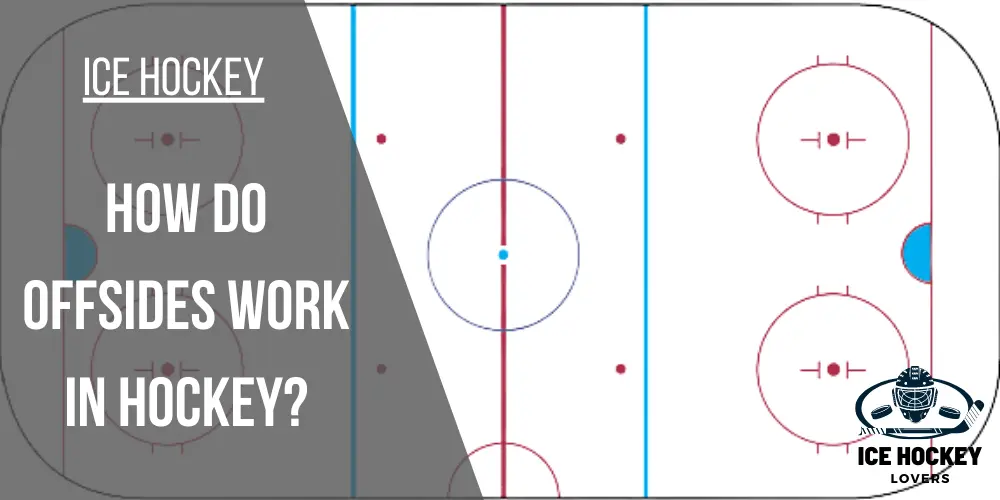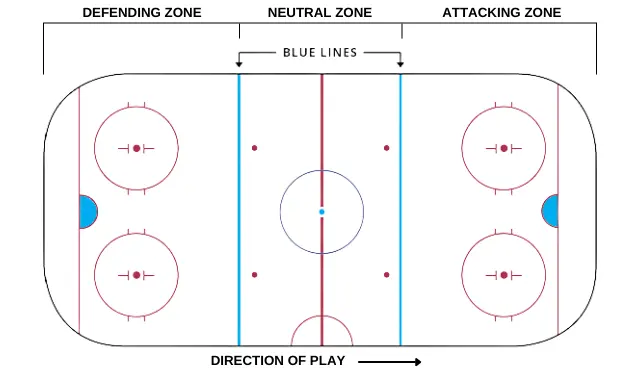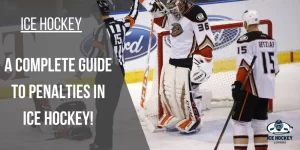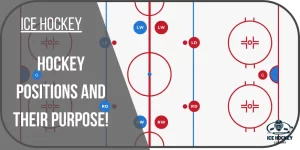What is Offsides in Hockey? Hockey Offsides Explained!

Ice hockey is an exhilarating sport that combines skill, speed, and strategy. One crucial aspect of the game that players, coaches, and fans must understand is the concept of “offsides.” Whether you’re a player, coach, or ice hockey fan, understanding the offside rule significantly contributes to appreciating the sport to its fullest.
What is hockey offsides? Offside is a rule in hockey that leads to a pause in the game, calling offside when an attacking player moves across the blue line into the offensive zone before the puck. To determine if a player is offside, their skates must be completely over the blue line before the puck enters the attacking team zone.
In this article, we will delve into the intricacies of offsides in the hockey game, its significance, rules, and its impact on the game.
Table of Contents
The Offsides Rule: Understanding the Mechanics
To gain a clearer understanding of offsides, let’s break down the rule into three zones and its essential components:
1. The Blue Line
The blue line before the puck, which divides the offensive and defensive zones, stops play and plays a pivotal role in determining offsides.

Each team’s name crosses the blue line before the puck, which serves as a gameplay boundary. As players maneuver across the ice, they must be mindful of their position relative to this crucial demarcation.
2. The Puck’s Position
For an offsides infraction to occur, the puck in offending other teams, own defending zone’s defensive zone, the position is crucial. As the attacking team initiates a play, the first puck carrier must cross over the defending team’s blue line before any attacking player. Failure to abide by this rule results in an offsides violation.
3. Player Positioning
The players’ positioning in relation to the blue line and the puck is vital in determining offsides. To remain onside, all attacking players must have their skates on the blue lines or behind the puck entering the offensive blue line when it fully crosses the blue line into the offensive zone.
4. Delayed Offside
A delayed offside situation arises when one or more attacking players enter the offensive zone ahead of the puck. However, if the attacking players promptly exit the attacking zone before re-engaging in the play, the delayed offside call is nullified. This no-offside rule allows the defending team to clear the puck out of their zone without facing immediate pressure.
Strategies to Avoid Offsides
Teams employ strategies to minimize offside infractions and maintain a strong offensive presence. Here are a few techniques commonly used by players and coaches:
1. Timing and Communication
Effective timing and clear communication are essential elements to avoid offsides. Players must synchronize their movements, ensuring they enter the offensive team’s zone precisely when the puck crosses the defending team’s blue line. Open communication lines between teammates help execute seamless plays and maintain proper positioning.
2. Skate Control and Agility
Maintaining control over their skates is crucial for players to stay onside. Skating skills, such as quick stops, tight turns, and rapid changes in direction, allow players to adjust their positioning and prevent offsides. Practicing these skills regularly enhances players’ ability to react swiftly to game situations and make split-second decisions.
3. Offensive Zone Entry Tactics
Coaches often devise specific offensive zone and defensive zone entry tactics to mitigate the risk of offsides. These tactics focus on creating advantageous situations using offensive players, positioning, timing, and strategic passing plays. By carefully choreographing these plays, teams can precisely enter the offensive zone while minimizing the chances of committing an offsides violation.
The Implications of Offsides
Understanding the implications of offsides is crucial for both players and fans alike. Here are a few key points to consider:
1. Play Disruption and Momentum Shifts
When an offsides violation occurs, the play immediately stops, disrupting the game’s flow. The offending team is then penalized with a faceoff in the neutral zone before the puck is back, allowing the defending team to regain possession and potentially shift the momentum or power play in their favor. Therefore, avoiding offsides is essential for maintaining offensive pressure and avoiding unnecessary turnovers.
2. Goal Disallowance
If a goal is scored while a team is offside, it will be disallowed by the officials. This emphasizes the importance of maintaining proper positioning and adhering to the offsides rule. Scoring opportunities can be lost by delayed offside rule, and an intentional offsides violation can significantly impact the game’s outcome.
3. Defensive Strategies
Defending teams often use the offsides rule to their advantage. Defenders can force an opposing team into offsides by maintaining a strong defensive posture and carefully monitoring the attacking team in the neutral zone and players’ positions. This strategy allows defenders to gain control of the puck and initiate a counterattack, creating scoring opportunities for their team.
4. Tactical Adjustments
Coaches closely analyze offsides data to identify patterns and make strategic adjustments. They study their own defensive team side’s offensive entries and evaluate the success rates, enabling them to modify tactics, player positioning, and timing to optimize their offending team’s defensive zone and team side’s performance. Tactical awareness of offsides is essential for effective gameplay and exploiting the opposition’s weaknesses.
Controversies and Challenges in Hockey Offsides
Despite efforts to enforce the offsides rule consistently, there are instances where controversies arise due to its subjective nature.
Subjectivity in Offsides Decisions
Determining whether a player’s skate was on or behind the blue line when the puck crossed requires the officials’ judgment. The subjective element of making these calls can lead to disputes and debates among players, coaches, and fans.
Video Review and Offsides Calls
Many leagues have implemented video review systems to address the challenges posed by subjective offsides decisions. These systems allow officials to review contentious offsides calls using multiple camera angles and slow-motion replays, striving for increased accuracy.
However, video review itself can introduce new complexities. Delays in the game, technical limitations, and disagreements over interpretation can sometimes overshadow the intended benefits of using technology to resolve offsides controversies.
Offsides Challenges
Teams can challenge an offsides call in some leagues using a coach’s challenge. If the challenge is successful, the original call is overturned, potentially affecting the flow and outcome of the game. However, teams must use their challenges strategically, as incorrect challenges can result in penalties and lost timeouts.
Offsides in Relation to Other Hockey Rules
While offsides are a distinct rule, it interacts with other rules in hockey, influencing gameplay and strategies.
Icing vs. Offsides
Icing occurs when a player or team shoots the puck from their defensive zone across both the red line and the blue lines toward the opponent’s goal line, and no player touches it before it reaches the blue lines in goal or crosses the blue line. In contrast, offsides focus on player positioning at the blue line.
Understanding the differences between icing and offsides helps players and officials make appropriate judgments and avoid penalties.
Penalties and Offsides
If an offsides infraction occurs, the play is stopped, and a faceoff occurs outside and enters the other team’s offensive zone or the other team’s defensive zone. However, no penalties are typically assessed for offsides violations alone.
It is crucial for players to avoid committing other penalties simultaneously with an offsides violation, as this can result in more severe consequences, such as one team being shorthanded due to a penalty kill.
Offsides and Its Effect on Players
The offsides rule significantly influences players’ strategies and decision-making on both the offensive and defensive sides of the game.
Offensive Strategies
Offensive players must understand the offsides rule to time their entries into the offensive or defensive zone effectively. They must coordinate their movements with their teammates and anticipate the puck’s arrival at the offensive or crossing the blue line.
Skilled forwards often utilize deceptive moves, such as faking a pass or delaying their entry, to outwit defenders and gain an advantageous position. They aim to create scoring opportunities while avoiding offsides violations.
Defensive Strategies
Defenders play a crucial role in defending neutral and attacking zone ahead, preventing the opposing team brings players from gaining an offsides advantage. They aim to maintain a strong defensive formation and anticipate offensive players’ movements.
Defensemen often employ tactics such as maintaining a tight gap and utilizing their body positioning to force attacking players offside. A well-executed defensive strategy can disrupt the opponent’s offensive flow and provide counterattack opportunities.
Frequently Asked Questions
Can a player’s stick be ahead of the blue line during an offsides violation?
No, the rule specifies that both a player’s skates must be behind the blue line for a player to be considered onside. The stick’s position between two blue lines is not a determining factor in offsides violations.
What happens if a player touches the puck while offside?
If a player touches the puck while offside, the play is immediately stopped, and an offsides violation is called. A faceoff is then conducted outside the offensive zone of the hockey rink, with the team defending the player that committed the intentional offside or infraction.
Can offsides be reviewed using video replay?
Yes, in many professional hockey leagues, including the NHL, offsides can be reviewed using video replay. Coaches can challenge an offsides call, and if the challenge is successful, the original call may be overturned.
Why are the offsides rule important in hockey?
The offsides rule is essential in hockey to ensure fair play and balance between attacking and defending teams. It prevents players from gaining an unfair advantage or advantages by entering the attacking or defending zone either before the puck ahead or the offensive zone ahead of the puck, promoting strategic gameplay and maintaining the integrity of the sport.
Conclusion
The offsides rule in hockey plays a vital role in maintaining fair play, strategic decision-making, and the overall dynamics of the game. Understanding its intricacies enhances players’ and fans’ experiences, enabling them to appreciate the strategic elements and suspense it adds to each play.
Offsides remains a subject of debate and challenge, with ongoing efforts to strike the right balance between accuracy, speed of play, and the integrity of the game. As hockey continues to evolve, the offsides rule will likely evolve alongside it, shaping the future of this beloved sport.

Who is Austin Taylor?
Meet Austin Taylor, your go-to source for everything ice hockey! With a passion for the sport that’s as deep as the ice itself, Austin Taylor brings you concise, expert insights and nitty-gritty details on all things hockey. From gear reviews to strategy breakdowns, Austin Taylor is your trusted guide to navigating the exhilarating world of ice hockey. Get ready to lace up your skates and dive into the game with Austin Taylor as your ultimate companion.




